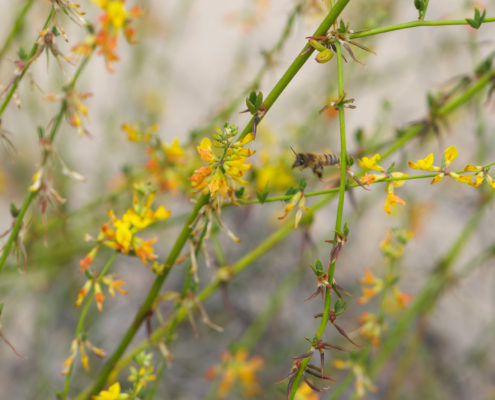When the Santa Ana winds rush through the Cajon Pass, scouring over its creeks and mountains, the winds lift and carry fine sand that settles to the valley below. For thousands of years the Santa Anas have shaped the contours of the Inland Empire, depositing fine Delhi sands into a stretch of dune formations that once covered fifty square miles of San Bernardino and Riverside Counties. The Delhi sand dunes seemed barren to those who didn’t look closely. Much of the habitat was converted to vineyards and citrus groves, which gave way to industrial and commercial construction. By the early 1990s, only a sliver of the habitat remained.
Greg Ballmer, a longtime board member, volunteer and supporter of Rivers & Lands Conservancy has always been a passionate entomologist. So, Greg had a very clear vision of where to find the unique habitats in the Inland Empire, habitats that harbored insects rare and yet to be discovered.
Greg was aware of one insect that could be found in the inland dunes and nowhere else in the world. The elusive Delhi sands flower-loving fly was about to disappear before science understood much about the species and its habitat. We would never learn about its interconnection with native plants, formally name other rare species like the Colton Dunes Jerusalem Cricket, or possibly discover new species that could only be found in the dunes. So, racing to stay ahead of its destruction, Greg authored the petition to list the fly as an endangered species and protect what was left of the rare habitat.
Yet, the listing of a species that many politicians and community members considered nothing more than a fly gave rise to a contentious battle that pitted development against conservation. It was waged for years even as the fly was federally listed as endangered in 1993. Greg remains an outspoken advocate for the Delhi Sand Dunes, a habitat that is unique to the winds and particular wilds of the Inland Empire.
Today, thanks to the work of Greg and the many partners who fought to protect its habitat, Rivers & Lands Conservancy manages the largest acreage of land conserved for the federally endangered Delhi sands flower-loving Fly. We manage just under 200 acres with another 70 to be added over the next couple of years.
Delhi Sands Flower-Loving Fly Outreach & Education
Michael Viramontes, an Rivers & Lands Conservancy land steward, knew that it wasn’t enough to just preserve habitat for the fly. As Rivers & Lands Conservancy fought a constant battle against illegal trash dumping on conserved lands, it was obvious that simply fencing properties and excluding the local community was not the answer. Long term conservation of the fly was going to require the education and involvement of the local community to instill a sense of pride for this species and habitat they could call their own.
So, he spear-headed a Delhi Sands Flower-Loving Fly Education and Outreach Program, giving presentations to local high schools and inviting volunteers to help with caring for fly habitat. Volunteer opportunities include trash removal, native habitat planting events, seed collection, and native plant nursery workdays.
“During one of my presentations, I was telling the kids that so little is known about the fly that it’s easy to become an expert,” Michael said. “You can read the Wikipedia page and know more than just about anyone else. You could easily work to become the next leading expert on an endangered species right in your community and be someone who makes an impact."
Michael says his dream is to get a local high school to change their mascot to the Delhi sands flower-loving fly. We think he'll make it happen!
Want to join us or volunteer?
What is a Delhi Sands Flower-Loving Fly?
Not your average fly!
- The Delhi sands flower-loving Fly (Rhaphiomidas terminatus abdominalis), is approximately 1-inch long and is orange-brown in color. It has dark brown oval spots on the upper abdomen like a honeybee.
- Despite its name, it is unclear if the fly actually feeds on nectar from flowers. Some scientists hypothesize that the flies only eat during their larval stage or that the flower it nectars from has been extirpated from its dune habitat.
- Because of their small population, small geographic range, and short adult lifespan, not a lot is known about the fly or how it interacts with its environment.
Why haven’t I seen one?
- Flies spend about 95% of their life underground inside the dunes!
- The adult flies live a brief life between July and September — the hottest months of the year! During that period, they are only active during the hottest part of the day, from 10am—2pm.
- The female flies sit on flowers waiting for a cruising male to find her. After mating, females lay their eggs 3-5 cm below the sand. Fly larvae hatch from the eggs in 11-12 days beginning the life cycle anew.
- Since not much is known about the fly, scientists study closely related species. Based on these studies, they believe the larvae are predators, traveling down to depths of 10 feet in the soil preying upon the larvae of other species until the conditions are right to pupate and emerge as adults.
What Else Lives in the Delhi Sand Dunes?
SUPPORT OUTDOOR EDUCATION
Interested in helping to shape our future conservation leaders and our work to preserve endangered habitats and species? Donate or become a member! We depend on support from grantors, corporate sponsors, and community members to offer these free programs to youth in our region.
Thank you for helping our community explore, connect, and care about wild open spaces and their future.



























